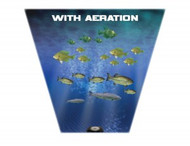Year Long Aeration for Your Pond
Published by Dan on Aug 7th 2018
It is imperative that you run your air pump 24 hours a day 7 days a week to build up the oxygen level to the maximum your pond can hold and then maintain it at maximum level. Pond water only holds approximately 6 to 8 parts per million of oxygen. This is the equivalent of 0.0008% compared to the atmosphere which holds 21%. Fish, aquatic plants, algae, small organisms and bacteria in your pond use oxygen to function. In many cases the “oxygen demand” of the pond can exceed the “oxygen input”, especially at night when the algae actually removes oxygen through the process of respiration. A dirty pond will have a higher oxygen demand than a clean pond due to the increased consumption of oxygen by the bacteria during the decomposition process. Maintaining high oxygen levels in your pond should be your number one priority all year long.
Ponds aerate in two ways.
1) Air bubbles dissolve oxygen directly to the surrounding water. The smaller the bubble the better the dissolution. To create a small air bubble you need an air pump and a small bubble diffuser. However, small bubble diffusers typically clog up quickly and require more frequent service or cleaning. A small bubble diffuser will put excess back pressure on your air pump and increase the service intervals.
2) Surface turbulence. Such as is created by a waterfall or a rising column of air bubbles bursting at the surface of the pond. A waterfall can create sufficient oxygen if it has many multiple splash points before it returns to the pond. The waterfall must also be of sufficient size and flow rate so that it turns the pond over at least 1 to 3 times per hour. Oftentimes a waterfall by itself is not enough for the oxygen demand of your pond.
A rising column of medium size bubbles lifts water from the floor of the pond to the surface bursting and creating surface turbulence which expands out in all directions. This method can actually circulate thousands of gallons per hour throughout the pond. The pond breathes through the surface air / water interface. Oxygen enters the pond from the atmosphere and carbon dioxide is expelled from the water. The more turbulent the surface agitation is the better the process works. This method only requires a medium size bubble which means a diffuser that will clog less frequently and put less back pressure on the air pump. Your air pump will run longer between service intervals. Our Matala rubber membrane air discs and air hose diffusers produce a medium size bubble and do not add back pressure to the Matala air pump.
In our experience, the simple airlift creating surface turbulence is the best and most economical method to increase oxygen levels throughout your pond very quickly. The airlift also creates circulation which can help to bring debris to your filter and skimmer intakes. The increased movement throughout the pond is extremely beneficial to health of the pond.

In the summer the warm water holds less oxygen but the activity level of the fish and other organisms increase and so does their oxygen demand. Place your air diffuser in the middle of the pond at the deepest point for the most efficient air lift and surface turbulence. In Japan, the koi breeders say that the best aeration for the pond is when you have so much surface turbulence that you cannot even see the fish. Of course this is not what most hobbyists want to hear but consider putting the air pump on a switch or a timer so that you may view your koi during feeding times or weekends. The rest of the day just bubble like crazy. Your fish and pond will be cleaner and healthier. Alternatively, place your diffuser in a corner or along a back wall where it will not interfere with your viewing enjoyment of the fish. Do consider how the placement of your air diffuser will affect the performance of your skimmers. Improper placement can push debris away from your skimmers. Use the surface movement created by the bubbles to compliment your skimmer suction.

In the winter time, in very cold climates, your pond may freeze over with ice. The ice will block the air / water surface interface and suffocate your pond. The water surface is the lungs of your pond. Place your air diffuser just 12 inches below the surface of the pond on a support of blocks or stones. The bubbles will keep an air hole open so the pond can still breathe. Do not put the diffuser on the bottom of the pond in the winter if water temperatures go below 45 degrees. A deep diffuser will circulate the entire pond top to bottom and will bring cold water to the bottom of the pond. If your diffuser is near the surface then the bottom of the pond will be calmer and actually stay a few degrees warmer so the fish can just hibernate without freezing.

